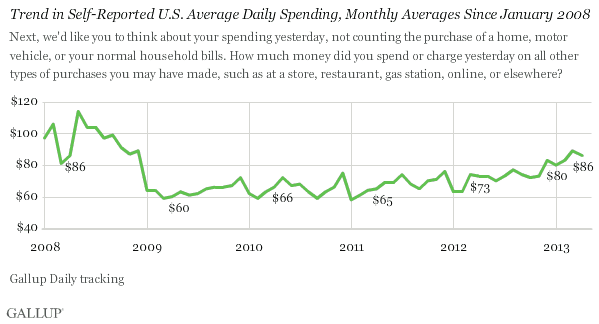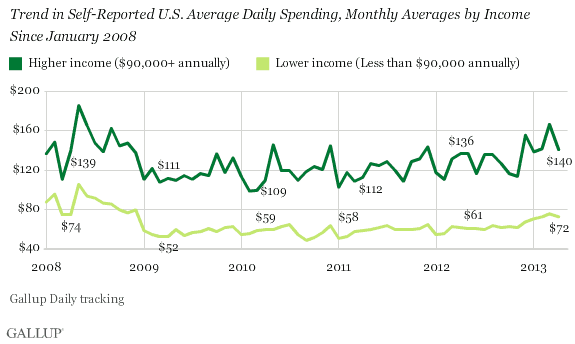WASHINGTON, D.C. -- U.S. self-reported daily consumer spending was $86 in April, not much different than the $89 in March or February's $83. This lack of change in consumer spending since February could reflect a number of issues, including the end of the payroll tax holiday.

These results are based on Gallup Daily tracking interviews, conducted by landline and cellphone, with more than 15,000 Americans from April 1-30. Gallup's consumer spending measure is essentially a discretionary spending measure and is generally more closely related to chain-store sales and online sales than overall retail sales.
This year's early Easter may have had some effect on April versus March consumer spending comparisons. Regardless, consumer spending that would normally increase in March and April before seasonal adjustment has been flat since February. Longer-term, Americans' self-reported spending is much stronger than it was from late 2008 to late 2011. Spending has been inching up in general since then.
Upper-Income Spending Declines Last Month
Upper-income spending fell to $140 in April from $166 in March, and is essentially the same as the $144 average in February. Lower- and middle-income spending averaged $72 per day in April, not much different than the $75 per day in March and identical to the February reading.

Lower- and middle-income weekly spending has been relatively flat over the past two months. Although weekly upper-income spending tends to be more volatile due to smaller sample sizes -- and increased sharply to an average $204 for the week ending April 21 -- the data suggest an overall downward trend in upper-income spending over the past two months.

Implications
Gallup's self-reported consumer spending measure suggests an absence of the usual seasonal spending increases seen in March and April. This is consistent with the slow sales many retailers reported and the overall slowing of the economy in recent months. It may also reflect the delayed impact on consumer spending of the elimination of the payroll tax holiday. It is also possible that the weak March jobs report is playing a role.
While one might expect falling gas prices at the pump to provide consumers with the ability to spend in other areas, this does not appear to be the case as of yet. Gallup does find that increased consumer optimism about housing prices has a "wealth effect": that is, as Americans see that the value of their home has increased, they feel their personal balance sheet or wealth has also increased, leaving them in a stronger financial position -- having higher net worth -- and thereby making them more comfortable spending. In turn, financially comfortable consumers may have a positive impact on consumer spending over time.
Consumer spending remains key to the growth of the U.S. economy, particularly upper-income discretionary spending. While economic confidence has been on the rise, such an increase in confidence may be a necessary, though perhaps not sufficient, condition for increased spending. Real improvement in the economy is more likely to be based on a real improvement in the job market.
Gallup.com reports results from these indexes in daily, weekly, and monthly averages and in Gallup.com stories. Complete trend data are always available to view and export in the following charts:
Daily: Employment, Economic Confidence, Job Creation, Consumer Spending
Weekly: Employment, Economic Confidence, Job Creation, Consumer Spending
Read more about Gallup's economic measures.
View our economic release schedule.
Survey Methods
Results are based on telephone interviews conducted as part of the Gallup Daily tracking survey April 1-30, 2013, with a random sample of 15,311 adults, aged 18 and older, living in all 50 U.S. states and the District of Columbia, selected using random-digit-dial sampling.
For results based on the total sample of national adults, one can say with 95% confidence that the maximum margin of sampling error is ±1 percentage point.
Interviews are conducted with respondents on landline telephones and cellular phones, with interviews conducted in Spanish for respondents who are primarily Spanish-speaking. Each sample of national adults includes a minimum quota of 50% cellphone respondents and 50% landline respondents, with additional minimum quotas by region. Landline telephone numbers are chosen at random among listed telephone numbers. Cellphone numbers are selected using random digit dial methods. Landline respondents are chosen at random within each household on the basis of which member had the most recent birthday.
Samples are weighted to correct for unequal selection probability, nonresponse, and double coverage of landline and cell users in the two sampling frames. They are also weighted to match the national demographics of gender, age, race, Hispanic ethnicity, education, region, population density, and phone status (cellphone only/landline only/both, cellphone mostly, and having an unlisted landline number). Demographic weighting targets are based on the March 2012 Current Population Survey figures for the aged 18 and older U.S. population. Phone status targets are based on the July-December 2011 National Health Interview Survey. Population density targets are based on the 2010 census. All reported margins of sampling error include the computed design effects for weighting.
In addition to sampling error, question wording and practical difficulties in conducting surveys can introduce error or bias into the findings of public opinion polls.
For more details on Gallup's polling methodology, visit www.gallup.com.
